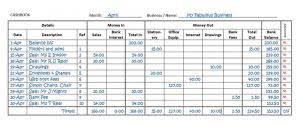
Sure, you must record the transactions that take place like in regular business accounting. But as an AG business, you also need to record your stock levels and the market value of your land. A single platform to manage finances streamlines operations, reduces errors, and improves overall efficiency, making it a critical asset for agribusinesses. Customizable accounting workflows streamline compliance and improve operational efficiency.
Ask a Financial Professional Any Question
Normal what is agricultural accounting management systems are unable to handle the special attention that is required for several processes to operate cross-functionally in farm farm accounting management. The best action to take for lower costs and increased output on your farm is to integrate accounting software for farm into your farm accounting management practice. These documents, which include balance sheets, income statements, and cash flow statements, provide an in-depth view of a farm’s financial health.

Our Team Will Connect You With a Vetted, Trusted Professional
- Among these principles, understanding depreciation and amortization and maintaining accurate farm bookkeeping stand out as critical components.
- Let’s dissect some fundamental concepts in accounting software for farm production to enhance your general agricultural management system.
- By maintaining accurate financial records, farmers can engage in better financial planning.
- This post is to be used for informational purposes only and does not constitute legal, business, or tax advice.
Complete a summer internship with a Fortune 500 company like John Deere, Caterpillar, Archer Daniels Midland or a public accounting firm like Deloitte or Price Waterhouse Coopers or Crowe Horwath. In the competitive world of farming, precise record-keeping could mark the difference between a farm that merely survives and one that truly thrives. Take self-paced courses to master the fundamentals of finance and connect with like-minded individuals. Ask a question about your financial situation providing as much detail as possible. Our mission is to empower readers with the most factual and reliable financial information possible to help them make informed decisions for their individual needs. This team of experts helps Finance Strategists maintain the highest level of accuracy and professionalism possible.
- The core principles of farm accounting include accurate bookkeeping of all farming transactions and understanding depreciation and amortization of assets.
- Farm accountants help decipher loan terms and prepare crucial financial statements necessary for loan application approvals.
- Unconditional grants related to biological assets measured at fair value less costs to sell are recognised as income when the grant becomes receivable.
- If you’re a farmer or involved in the farming industry, you need to be on top of things on the accounting side of your business.
- All such information is provided solely for convenience purposes only and all users thereof should be guided accordingly.
- All costs of raised trees and vines are accumulated and capitalized as Non-current farm assets.
Why are agricultural accountants important in agribusiness?

If you’re ready to put the right tools in the back office, get in touch with the FBS team today. Agriculture accounting is an essential component of managing a successful farming business. By understanding and implementing effective agricultural accounting practices, farmers can maintain their financial health, make informed decisions, and ensure long-term success. Whether through advanced accounting software, professional consulting services, or ongoing education contribution margin and training, investing in agriculture accounting is crucial for the future of the farming industry.
- These documents are indispensable tools for farmers, providing a snapshot of the operation’s financial status and enabling stakeholders to assess the farm’s economic health and performance.
- This method provides a more accurate picture of a farm’s financial health at any given time by recognizing receivables and payables.
- Recognizing these payments requires an understanding of the program’s stipulations and the appropriate accounting period in which to record the revenue.
- Revenue includes sales of crops, livestock, and other products, while expenses encompass costs such as feed, seeds, labor, and utilities.
- We follow strict ethical journalism practices, which includes presenting unbiased information and citing reliable, attributed resources.
- They allow agribusinesses to adapt quickly to changes in regulations or business needs while reducing the risk of human error.
What are farm business expenses?

Navigating the labyrinthine world of taxes is a significant aspect of farm management, with implications for the financial well-being of any agricultural enterprise. Farmers must be cognizant of specific tax provisions and incentives that are designed to support the agricultural industry. These tax considerations can have a substantial impact on a farm’s annual financial obligations and long-term strategic planning. Effective tax planning ensures efficient cash flow management, thereby fostering the farm’s long-term financial stability. Their broad understanding of the financial intricacies of farming operations makes them a vital partner for farmers, ensuring the financial health and sustainability of the farm. Agricultural accounting deals with unique aspects like seasonality, biological assets, inventory management in agriculture, and specific government subsidies and tax regulations.
- 1-800Accountant assumes no liability for actions taken in reliance upon the information contained herein.
- Farm entrepreneurs must be aware of the financial health of their businesses and possess a firm grasp of accounting concepts.
- The IRS lets certain farm businesses postpone reporting the gain from additional animal sales if you can prove that the sale was weather-related.
- But, it wasn’t until the 1990’s that data management systems really took off, despite…
- Farm accounting management systems are essential to achieving productivity and profit objectives because there are so many variables to monitor.
- Agriculture accounting software provides performance insights on livestock, including health, productivity, and profitability, which helps finance managers make better resource allocation decisions.
Owner’s equity represents the farmer’s stake in the farm after liabilities are subtracted from assets. This statement is crucial for understanding the liquidity and solvency of the farm, which are indicators of its ability to meet short-term obligations and to sustain operations in the long run, respectively. Farm accounting is underpinned by a set of core principles that guide the recording and analysis of financial data. These principles ensure that the financial information is reflective of the farm’s actual economic activities and provides a foundation for informed financial decision-making. Understanding Bookkeeping for Veterinarians these principles is crucial for maintaining accurate and reliable financial records. Discover the key elements of farm accounting, from foundational principles to financial statements and effective management practices for agricultural success.


It lists the farm’s assets, liabilities, and owner’s equity, offering a comprehensive view of what the farm owns and owes. Assets are typically categorized as current (cash or assets that can be converted into cash within a year) or non-current (long-term assets like land and equipment). Liabilities are similarly divided into current (debts due within a year) and long-term obligations.
















